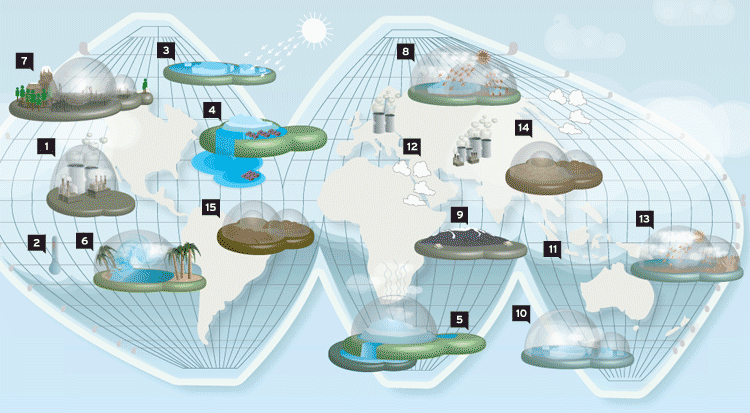
Global Harming
A glance at the damage already done from pole to pole—and what scientists say is still to come.
1. Poison in the Air
Greenhouse gases—caused by burning fossil
fuels such as oil, coal, and gas—can stay in the atmosphere for centuries, trapping heat from the Earth's surface and warming the planet. Greenhouse gas emissions jumped 70 percent between 1970 and 2004. Ice cores suggest that the current atmospheric concentration of carbon dioxide—the greenhouse gas most produced by humans—far exceeds the natural range of the past 650,000 years.
TOP
2. Warm Water
Oceans have absorbed 80 percent of the heat we've added to the climate, increasing average water temperatures even at depths of almost 10,000 feet.
TOP
3. On Thin Ice
The Arctic warmed twice as fast as the rest of the planet over the past 100 years. Its cap of sea ice has shrunk by an average of 8.4 percent each decade since the 1970s, and this year reached a record low. The less Arctic ice there is to reflect sunlight, the more heat the sea absorbs.
TOP
4. Rising Tide
For the past two millennia, the sea level has risen between 0.1 and 0.2 millimeters per year. Rates have averaged 10 times that in the past century, and 30 times that since 1993.
TOP
5. Oh-No-Zone
First observed in the early 1980s, the hole in the Antarctic ozone—the stratospheric gas that protects Earth from ultraviolet light—now grows to an area larger than Antarctica most years. At the South Pole
itself, ozone depletion reached 99 percent in early October 2006.
TOP
6. Perfect Storms
Tropical sea surface temperatures during the hurricane season have increased 1°F since 1970, possibly boosting the intensity of North Atlantic storms. The number of category four and five hurricanes—registering winds of more than 131 mph—has nearly doubled worldwide since then.
TOP
7. Acres Ablaze
Significant drought affected 52 percent of the United States in 2006 and contributed to a record wildfire season in which almost 10 million acres burned.
TOP
8. Not So Permanent
The top layer of permafrost has increased in temperature by 5.4°F since the 1980s, causing some to thaw for the first time in more than 125,000 years. As it melts, permafrost releases concentrated volumes of the greenhouse gas methane.
TOP
9. Goodbye, Glaciers
The 11,000-year-old ice caps of Mount Kilimanjaro in Tanzania have melted by about 82 percent over the past century—and could be gone altogether by 2020.
TOP
10. Shrinking Antarctica
In the space of 35 days in 2002, about 1,255 square miles of Antarctica's Larsen B ice shelf disintegrated into the ocean. Until this event, scientists estimate the sheet measured more than 700 feet in thickness and had likely existed for 12,000 years. It is now 40 percent of its previous size.
TOP
11. Submerged
If current warming trends continue, sea levels could rise as much as 3.5 inches by 2100. However, the real danger is if Greenland's ice sheet begins to rapidly melt. Even if only part of it slides into the Atlantic, this would cause flooding along the Gulf Coast and the eastern seaboard from Boston to Miami, while places such as Bangladesh would become uninhabitable. If the ice sheet melts completely, as some scientists predict, it could raise sea levels by 23 feet, submerging much of Florida and threatening London and Los Angeles.
TOP
12. Carbon Overload
Experts predict global emissions of carbon dioxide will jump an additional 75 percent by 2030.
TOP
13. Loss of Life
By 2050, more than a million species of plants and animals may be on the road to extinction as a result of global warming. Nearly 30 U.S. states could lose their official state trees or flowers, and seven may lose their state birds, as changing climates make those locations less habitable.
TOP
If summer ocean temperatures increase by just 1.8°F, the world's coral reefs—considered the "rain forests of the ocean" for their rich, delicate ecosystem—could cause them to die en masse. During one of the warmest periods on record in the late 1990s, about 16 percent of reefs worldwide were severely damaged.
14. Unquenchable Thirst
By 2050, nearly one-sixth of the world's population—including some in the western United States—will face water shortages as they receive 10 to 30 percent less snowpack runoff than today.
TOP
15. Agriculture
More frequent floods and droughts will decrease crop production, especially in low-altitude, subsistence regions. While the number of people worldwide facing food shortages is expected to fall by 2085—from 521 to 300 million—global warming will offset the decline, pushing the total back up by 69 to 91 million.
TOP
Illustration © Futurefarmers / Amy Franceschini







